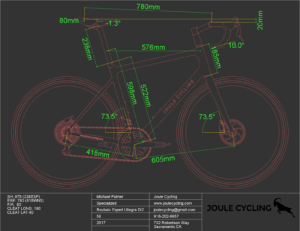Knowing the athlete’s background (training regime, injuries, time off the bike…), abilities (FTP-LTHR, racing category, racing results…) and goals (fitness, racing, adventures…) are vital to setting the distance between the saddle sweet spot and the handlebar (effective body extension) along with the height of the handlebars (above horizontal). These two parameters are flexible to a small degree and can be decreased depending on the intake assessment.  I say decreased as the solution created via the fit measurement process results in the ultimate best position of the athlete so, if the athletes current effective body extension is 30 or more millimeters less than the solution I will compensate for the discrepancy and explain the need to ease into the new position i.e. a more aggressive position. The example to the left illustrates a relaxed above horizontal and somewhat compact effective body extension. The reason being is based on the athlete’s background which at the time entailed low weekly volume, complete mostly on the flats and a goal of competing in recreational century rides. So, I decided (along with his feedback) to focus on comfort over aerodynamic position so his above horizontal (20 millimeters) is vastly different from an athlete who races criteriums, for example. The long and short of the post is that there is no one size “fits” all when it comes to professional level bike fits. #specializedroubaix
I say decreased as the solution created via the fit measurement process results in the ultimate best position of the athlete so, if the athletes current effective body extension is 30 or more millimeters less than the solution I will compensate for the discrepancy and explain the need to ease into the new position i.e. a more aggressive position. The example to the left illustrates a relaxed above horizontal and somewhat compact effective body extension. The reason being is based on the athlete’s background which at the time entailed low weekly volume, complete mostly on the flats and a goal of competing in recreational century rides. So, I decided (along with his feedback) to focus on comfort over aerodynamic position so his above horizontal (20 millimeters) is vastly different from an athlete who races criteriums, for example. The long and short of the post is that there is no one size “fits” all when it comes to professional level bike fits. #specializedroubaix